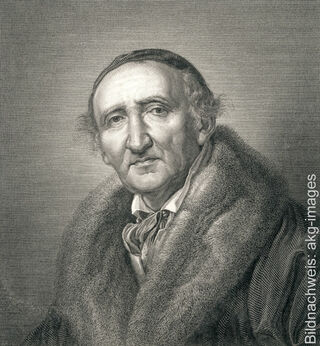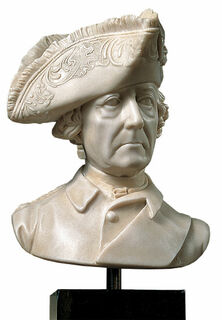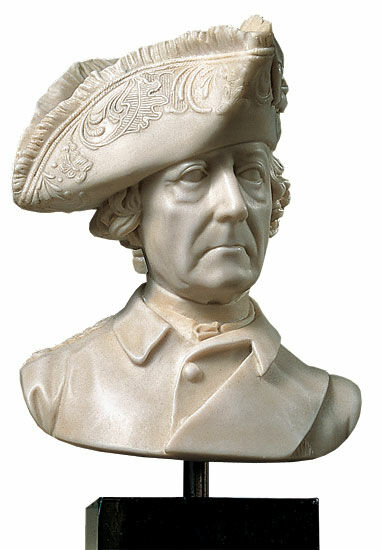Bust "King Frederick II", cast
Bust "King Frederick II", cast
Quick info
museum replica | cast | total height 37 cm
Detailed description
Bust "King Frederick II", cast
Even during his lifetime, he became a legend. The name Frederick the Great stands for an enlightened Prussia. On the one hand, heroic steadfastness and, on the other, artistic subtlety are among the well-known attributes of the Frederician era, this fascinating period of German history. With the help of an army that had grown to 180,000 men by the end of his term of office, Frederick II secured Prussia's European supremacy. Domestically, the progressive regent represented the ideal of enlightened absolutism. As a far-sighted patron of the arts, architecture and sciences, Frederick the Great is responsible, among other things, for the construction of the famous Sanssouci Palace in Potsdam.
This portrait of the king is one of the most precious treasures of European art. Joh. Gottfried Schadow shows Frederick the Great in a typical pose with a sceptical, vigilant face and his head slightly tilted to one side.
Original: Sanssouci Palace, Potsdam. Marble.
Polymer ars mundi museum replica, cast by hand. Height incl. pedestal 37 cm.
Customer reviews
Meine Erwartungen wurden übertroffen. Die Lieferung erfolgte prompt, die Büste war perfekt verpackt. Das Kunstwerk gefällt mir und vor allem dem Beschenkten sehr gut.

About Johann Gottfried Schadow
1764-1850
Johann Gottfried Schadow was the most important German sculptor of the Napoleonic era. He trained at the royal school of sculpture and later became head of the court sculpture workshop and "director of all sculptures" in 1788. Schadow's classical ideal was increasingly joined by realistic, national and individual features. His classically ideal and realistic style set the trend for the 19th century.
His art combines a natural sensuality and grace leading out of the Rococo with great realism. His double statue of the crown princesses Luise and Friederike of Prussia in marble is the first life-size double statue of classicism and set standards for 19th-century monument sculpture. He created the famous quadriga on the Brandenburg Gate in copper rubbing, as the bronze casting technique could not yet be used for such large objects. During the Restoration period, Schadow's realistic classicism found fewer patrons and was supplanted around 1820 by the official and emphatically representative art of his pupil Caspar Daniel Rauch.
Until his death, Schadow was director of the Berlin Academy and exerted great influence, also through his writings.
Sculptural representation of person's head and shoulders.
The term refers to the art movements of ancient, mostly Greek models.
According to the current understanding, classicism is the period between 1750 and 1840 when the late Baroque was gradually replaced by classically orientated art. The great explorations of Greek art and architecture at that time awakened a true enthusiasm for antique models. The Glyptothek in Munich, the Panthéon in Paris, The New Guard House (Neue Wache) and the Brandenburg Gate in Berlin are just a few examples of the revived classical style.
The leaders of the statuary art were Antonio Canova, Bertel Thorvaldsen and in Germany Johann Gottfried Schadow and Christian Daniel Rauch.
In painting, the outstanding representatives of this style are Jaques-Louis David or Jean-Auguste-Dominique Ingres.
Collective term for all casting processes that ars mundi carries out with the help of specialised art foundries.
Stone casting
Similar to artificial marble, with the difference that the substitute stone in powder form is used instead of marble powder.
Bonded Bronze (Cold-Cast-Bronze)
Bronze powder is polymer-bonded. Special polishing and patination techniques give the surface of the casting an appearance similar to the bronze.
Imitation Wood
In order to guarantee absolute fidelity to the original, an artificially manufactured imitation wood is used as a base material that features typical wood characteristics: density, workability, colour and surface structure.
Ceramic Mould Casting
Ceramic mould casting usually requires the use of casting clay, which is then fired and optionally glazed. Instead of the usual rubber moulds, plaster moulds are often used in ceramic casting and porcelain production.
Cast Bronze (Lost-Wax Casting)
For the cast bronze, the thousand-year-old lost-wax technique is used. It's the best, but also the most complex method of producing sculptures.
A true-to-the-original reproduction of an artwork in the same size and with the best possible material and colour uniformity.
The mould is usually taken directly from the original so that the replication reproduces even the finest details. After casting the replication, using the most appropriate method, the surface is polished, patinated, gilded or painted according to the original.
A replication of ars mundi is a recognizable copy of the original.
A plastic work of sculptural art made of wood, stone, ivory, bronze or other metals.
While sculptures from wood, ivory or stone are made directly from the block of material, in bronze casting a working model is prepared at first. Usually, it is made of clay or other easily mouldable materials.
The prime time of sculpture after the Greek and Roman antiquity was the Renaissance. Impressionism gave a new impulse to the sculptural arts. Contemporary artists such as Jorg Immendorf, Andora, and Markus Lupertz also enriched sculptures with outstanding works.


